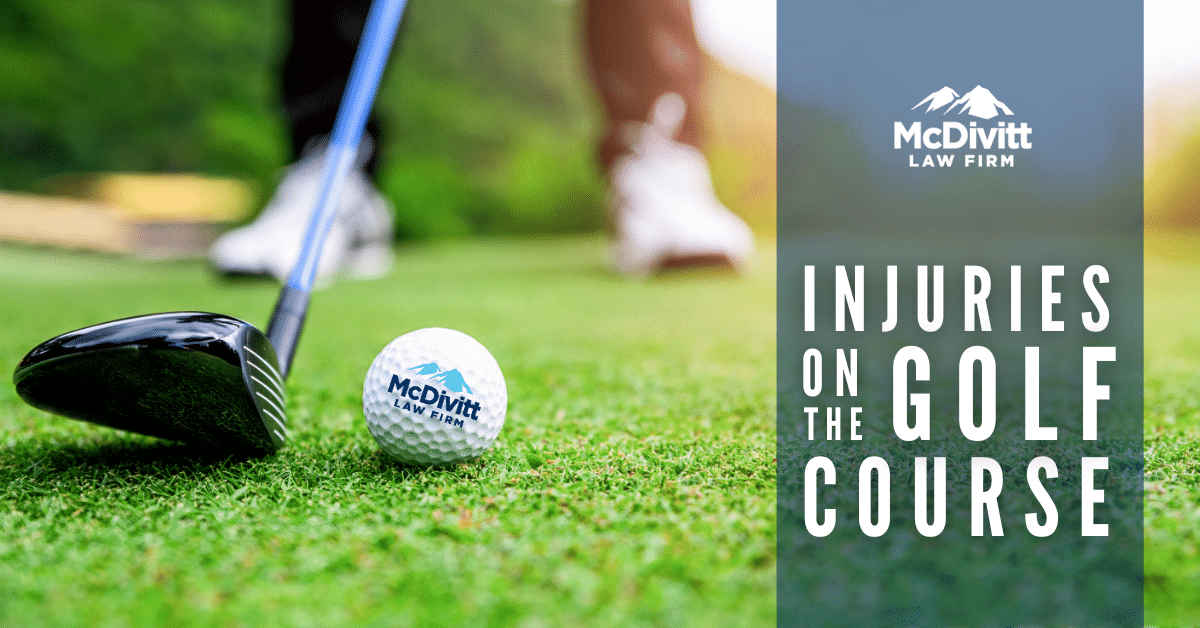
Have you ever watched golf on television and wondered what would happen if a spectator were struck with a golf ball? After all, the crowd is often standing mere feet away and offered little protection from an errant swing. Though the injuries could be severe, given the velocity and impact of a golf ball, a spectator would have an uphill battle in proving any negligence on behalf of a golfer or golf course.
Around the country there have been various disputes in court about being injured due to a golf ball striking a person in numerous scenarios. Each instance is different and comes with its own set of facts and circumstances, but each of these decisions gives an insight into who these disputes are handled around the country.
Colorado
The Colorado Court of Appeals has held that, “a spectator could not hold golfer liable for injuries sustained since, even if the golfer had given a warning before he made the shot, there was no indication from the spectator that she could have heard or would have headed the warning, since she was not in or near line of golfer’s intended shot, and no showing was made that any negligence on the part of the golfer was involved in hitting the ball.” The court ruled for the golfer due to the spectator being in a position to where they would not have been aware of the warning and nowhere near the intended direction of the golfer’s shot.
Kansas
A court in Kansas has held that, “The mere fact that a golf ball, after being struck, does not travel in its intended curse does not in and of itself establish negligence with respect to the manner in which the ball was struck. In this case, a woman was struck by a ball while across the street form a golf course.” The court ruled for the golfer because he yelled a warning for anyone that could have been in the direction that he intended to hit the ball. Additionally, the plaintiff was nowhere near where the potential zone of danger existed for the ball landing because she was sitting in a car across the street from the course.
New York
In New York the court goes further by saying that, “A golfer is not liable because his or her ball slices and injures another.” In this instance, a golf course employee was allegedly injured when the defendant sliced a shot away from the fairway. The court ruled for the defendant because the employe was not in the intended line of flight of the ball and the employee admitted to watching the defendant hit the ball and thus was aware of the ball’s flight path.
Louisiana
In Louisiana a court has held that, “a golf course operator had not duty to warn a jogger near the golf course of the danger of being hit by an errant golf ball where the jogger lived near the course, had previously jogged that route, knew that the route traversed a golf course, and observed golfers as her was jogging; moreover it was not reasonable to require that the golf course operator to erect barriers, reconfigure the golf course, or close the street to non-golfers.” The court ruled in favor of the golfer because he had been familiar with the area and knew that people were golfing at the course at the time he was running, and thus knew the potential danger that could occur while running near the golf course.
Massachusetts
Another interesting story comes out of Massachusetts, where a family was recently awarded $4.9 million after the Plymouth Country Superior Court determined that the Indian Pond Country club was at fault for not protecting the home. The couple bought their home back in 2017, which is located near the 15th hole of the golf course. While it is generally expected that some golf balls would strike homes adjacent to the course this was a different situation. The couple decided to take their case to court after around 650 golf balls had hit their home, breaking windows and continuously damaging their property. The couple had bought the home understanding that they would have a view of the golf course, but instead the home actually was becoming in play based on the number of balls hitting their home. In addition to the award of damages the country club has decided to relocate the tee box in order to prevent future golfers from continuously hitting the home.
What You Should Do:
As a golfer:
Golf is a game that requires players to observe certain rules of etiquette to ensure the safety and enjoyment of all participants. Here are some key etiquette guidelines for golfers on a course:
- Be aware of your surroundings: Before making a shot, make sure no one is in your immediate vicinity. Look ahead to see where other golfers are on the course.
- Keep a safe distance: When waiting to make a shot, stay a safe distance away from other golfers. Keep at least 10 yards away from anyone who is hitting the ball.
- Listen for warnings: If someone yells “fore”, duck or move out of the way quickly. This is a warning that a golf ball may be coming your way.
- Give warning: If your golf ball is heading towards another person or group on the course, yell “fore” to alert the other players of the possible danger.
- Be careful when driving a golf cart: Follow the speed limit and be aware of any hazards on the course, such as steep inclines or water hazards.
As a pedestrian:
If you live near a golf course or need to walk near one, it’s important to be aware of potential hazards to stay safe. Here are some safety tips for pedestrians near a golf course:
- Stay on designated walkways: Avoid walking on the golf course itself. Use designated walkways or sidewalks that are separated from the course.
- Be aware of your surroundings: Stay alert and look out for golfers who may not see you. Watch for warning signs and listen for any alerts from golfers, such as when they yell “fore”.
- Keep a safe distance: Stay a safe distance away from golfers who are hitting the ball. Avoid walking in the line of play between the tee and the green.
- Walk with a group: If possible, walk with a group to increase your visibility to golfers.
- Wear bright clothing: Wear bright clothing to increase your visibility to golfers. Avoid wearing green, which can blend in with the grass on the course.
- Avoid distractions: Avoid using headphones or being distracted by your phone while walking near a golf course.
- Be cautious around golf carts: Golf carts can be difficult to hear and see, so be cautious around them. Stay clear of golf cart paths and be aware of any oncoming carts.
Learn more about personal injury.


